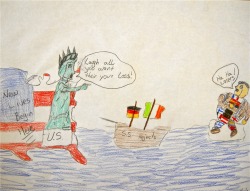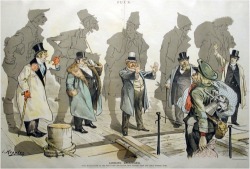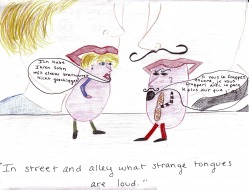 My 8th Graders have just finished their Immigration Unit. During the course of the unit, they read, compare and contrast poems about immigration by Emma Lazarus and Thomas Bailey Aldrich. I've written about this before. Interestingly enough, the father of a couple of former students used to work for the Strawberry Banke Museum in Thomas Bailey Aldrich's house as a historical interpreter. In fact, he is one of two Thomas Bailey Aldrich interpreters in existence. A few years ago, he offered to come speak with my class in character. This year, I took him up on it. I also asked a colleague, who is a well regarded performance poet if she could recommend a poet who could stand in for Emma Lazarus. As it turns out, she could. So, I invited both guests to come speak to my students in character, to discuss immigration. I envisioned it as a sort of Victorian Poetry Smack-Down. As it turns out, each guest was too polite and deeply interested in what the other had to say to describe this as a "smack-down"; it was more of a salon, which was probably a lot more interesting, anyway.
So, How Did It Go?Pretty well. Both guests were used to performing in front of people, so there was very little stage-fright. Almost all of my students were well-behaved. The discussion was interesting. Brandi MacDonald (the poet playing Emma Lazarus) read a poem of hers about the Statue of Liberty that was simply dynamite. Because our poet was not actually a historian and our historian was not actually a poet, we ended up splitting our time talking about Victorian society and the writing process, which, again, was probably more interesting, anyway. My favorite part of the morning was playing James Lipton and asking Thomas Bailey Aldrich and Emma Lazarus the questions from "Proustian Questionaire" from Inside The Actor's Studio. Here is the presentation in its entirety: As always, your comments are appreciated.
 I think this is the third year I've done this particular project with my students. As part of our Immigration unit, we spend a week or so examining old political cartoons dealing with immigration issues. (You'd be a little shocked at how viciously racist some of the 19th Century ones are.) We start out at a pretty basic level: Me: "What do you see?"
Student: "Um... A man??"
Me: "That's a good start!"By the time we've looked at and discussed ten or twelve of these, the analysis gets pretty sophisticated: Me: "Okay, why do you think the artist has drawn Uncle Sam as Moses?"
Student: "Um... I think he's saying something, you know, religious? Like maybe the U.S. has been chosen by God? You know - to lead people out of suffering?"Once we've spent several days doing this sort of analysis, we compare and contrast two poets and their most famous poems about immigration - Emma Lazarus and Thomas Bailey Aldrich. Lazarus' poem, "The New Colossus" is extremely well known - about half of the students have heard a line or two of it at some point - but Aldrich's poem, "Unguarded Gates" has mercifully sunk mostly into obscurity. Not to put too fine a point on it, it's pretty racist. There's a lot of material out there about Lazarus' poem that we can use in our discussion, but it's Aldrich who strikes a chord with our students. Early in our Immigration unit, we read about the Shapiros, a family of Russian Jews whose house is part of the Strawberry Banke museum in Portsmouth, New Hampshire, about half an hour from our school.
It turns out that Aldrich lived directly across the street from the Shapiro's house (though not when they lived there). The irony of this rabid xenophobe living 50 feet or so from this immigrant family's house really appeals to my guys' sense of cosmic justice.
Anyway, once we've discussed both poems - if not to death, then to something approaching it - each student is randomly assigned one of the poets and tasked with drawing a political cartoon that reflects Lazarus' or Aldrich's political philosophy.
The results are awesome:

☜(For the best view of the individual cartoons, click on the Expanding-Arrow-Thingy at the bottom of the movie screen.)
Your comments, as always, are welcomed and will be passed on to the artists.
 Joseph Kepler - 'Looking Backward', 1893
My classes are in the middle of their Immigration unit and I'm looking ahead to their final project.
The essential question for the unit is, "Who Deserves to Be an American?"
Yes, I know it's a provocative way to ask the question, but that's the idea; aside from learning about an important theme from American history, I want my students to be able to look at a controversial topic from several different angles, listen to a variety of opinions, and then form their own opinions. It's not important to me what their opinions are - just that they are based on something other than gut feeling.
We do some really interesting activities in this unit, which I'll post about soon, but their final assessment for the unit is to write a research paper.
Last year, I put together movies of the political cartoons that my students had drawn as part of our Immigration Unit. This year's class is just finishing up that same unit.
Here are their political cartoons:
Your comments are appreciated.
(To view the cartoons at a larger size, click the link above to watch them on Vimeo. There is a full-screen option there.)
Okay, admittedly it took quite a while to put the different pieces of this project together, but my 8th Grade Social Studies classes have just finished with an unbelievably, mind-numbingly, chew-on-the-carpet, kick-butt project. (Umm... in other words, the kids did a really good job on this.)
If you'll indulge me, let me tell you a story:
Our Immigration Unit is designed to make students think critically about an important, emotionally-charged issue and decide what THEY think based on facts, rather than what their parents or friends or teachers think. Our Essential Question for the unit is, "Who Deserves to Be an American?" (This is phrased deliberately provacatively.)
As part of this unit, the students look at a series of somewhere between 40-50 political cartoons from the early 1800s to present dealing with immigration. The kids are really good at picking out details in a these pictures and speculating about what they mean. By the time we have spent three or four class periods interpreting political cartoons, they usually have a really good grasp on political symbolism.
The next stage of the unit is looking at two poems written at roughly the same period in American history - Emma Lazarus' "The New Colossus" (the "Statue of Liberty Poem"), which was very supportive of the idea of new immigrants, and "The Unguarded Gate" by Thomas Bailey Aldrich, which took a much dimmer view of immigrants and the danger he thought they posed to American culture.
Now, this can get pretty hairy. Victorian poetry is awfully dense stuff at the best of times and Aldrich's poem is pretty ornate, even by the standards of the time. In past years, I've asked the students to translate these poems into modern American English. This was a mixed success at best. Really good students who liked working out puzzles did pretty well, but most of them just sort of closed their eyes and "punted" and really didn't learn much from the experience. This year, I decided to try another approach:
I had each student pull a colored poker chip from a jar (the Awesome Jar of Destiny - Da Da DAAAAAHHHHH!!) [Don't worry if you don't get the reference.]. Students with one color were assigned to draw a political cartoon expressing the point of view from Emma Lazarus’ poem. Students who pulled the other color were assigned to draw a cartoon from Aldrich’s point of view.
The cartoons I got back were stunning.
No. Seriously. They were really, really good. Professionally good, in some cases. So good, in fact, that I felt that they really needed to be brought to a wider audience. Here's what I did:
I scanned each cartoon, creating a digital image (a jpeg file) and put each class' work into a separate folder.
In class, using our classroom projector, we opened up PowerPoint and used the Photo Album function to drop all the student artwork into a presentation. It automatically created a title page slide, which we changed to suit the class' tastes. We also quickly highlighted all the slides with cartoons and formatted them to have a neutral color in the background.
Using a TuneTalk recording device and an iPod, student volunteers recorded descriptions for each of the following slides –
1. An explanation of “The New Colossus”,
2. A reading of the actual poem,
3. An explanation of Thomas Bailey Aldrich’s point of view,
4. A reading of his poem,
5. An explanation of the cartoon project.
Next, we edited each clip in Audacity, taking out all the pauses and mistakes. (Once each clip was edited and saved, the students loved hearing what it sounded like at a much higher or much lower pitch - the "chipmunk" or "kidnapper" versions.)
As a class, we searched for images to go with each commentary online and built slides with the images and the .wav files. The student whose voice was used on a given slide was given a lot of creative control over what the slide would look like and how it would run. Text could remain static for instance, or appear gradually, using the Wipe function. If he or she wanted it to appear gradually, the class needed to look at how many seconds the sound file took to play, then set the Wipe to run in that many seconds.
Each class picked a piece of music to play in the background, while the slides of their cartoons runs. They needed to calculate the number of seconds that the song was, then divided that by the number of slides that would run during the song. Then, as a class, they selected all those slides and set the animation to advance each of those slides automatically at that interval. (Less complicated than it sounds.)
Later on, I (maybe next year, it can be a student) played the PowerPoint and recorded it with AutoScreenRecorder, then used Microsoft MovieMaker to convert it to a movie file. The sound does not record with AutoScreenRecorder, so I ended up dragging and dropping the individual sound files that the kids had recorded into Movie Maker. Because I had recorded the PowerPoint in real time, they matched up more or less perfectly. I ended up with a video file that I was able to upload to our school server and to TeacherTube.
I'm really proud of th.
|






 RSS Feed
RSS Feed